Seed Saving: Vegetables
I started seed saving the year I got behind (way behind) on picking my pole beans. When I found a few (ok, lots) of bean pods that were swelling in their pods and starting to yellow I was in despair at a lost harvest.
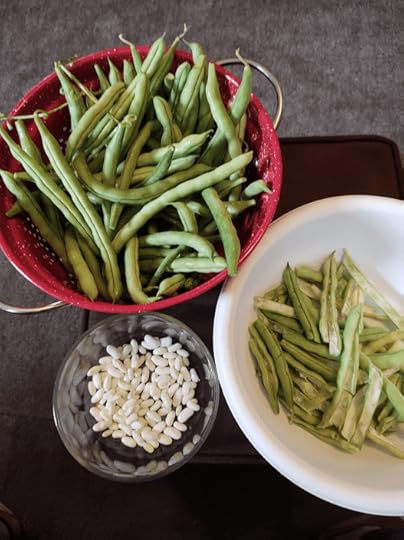
But, then a light bulb popped on.
These were not a waste- just a different stage of the plant.
I didn’t have to toss these overripe beans into the compost. I could leave these to grow and save them as dried beans. I could eat them or save to plant for more beans next year.
It was a sublimely empowering moment. One I want you to have too!
I got lucky by stumbling onto starting with one of the easiest vegetable seeds to save. For the first few years I saved mostly bean varieties and native flowers. Over a decade later, I’m still experimenting with saving new seeds. Which is why I’m well suited to pass the torch: if I can do it – you can too!
Why Save SeedsIt connects you with NatureYou can help sustain biodiversitySaves Real Money Plants become better adapted to your local climateSo let’s get started by Saving the Right SeedsIt connects you to your foodSeeds are Beautiful!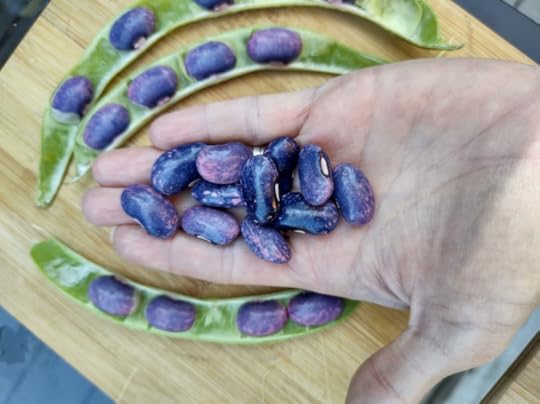 Beginner Seed Saver Tips:Save Seeds on a Dry DaySave Seeds from only the healthiest plantsSave Seeds from Heirloom + Open Pollinated plantsHave envelopes ready and labeled
Beginner Seed Saver Tips:Save Seeds on a Dry DaySave Seeds from only the healthiest plantsSave Seeds from Heirloom + Open Pollinated plantsHave envelopes ready and labeled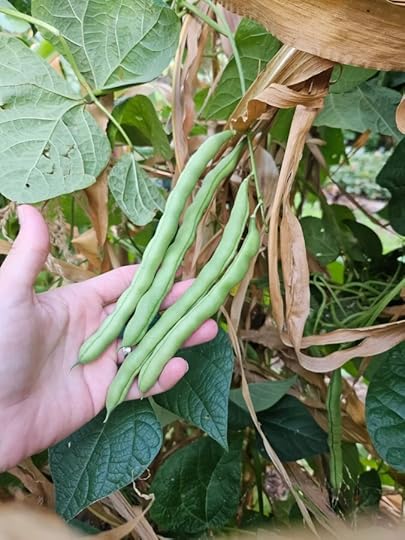 Heirloom vs Hybrid Seeds
Heirloom vs Hybrid SeedsYou may have heard about the difference between heirloom and hybrid varieties. One of the inherent values of an heirloom plant’s strength lies in its ability to reproduce itself. A bonus is that plants started from saved seeds regrown in the same location tend to produce plants better suited for the exact location they are grown in each season. this is called local adaptation. A plant is said to be fully adapted after about 7 years. Nature truly is amazing!
It is worth starting by finding out if the plants growing in your garden are heirloom or hybrids. Seeds from Hybrid plants will not re-grow the same plant. They will likely revert back to one of the two plants that were combined to make the hybrid.
SEED TYPESSeeds come in several types. Here’s what each name means.
Open PollinatedAny plant that is pollinated naturally by the wind or pollinators. Seeds will produce true-to-type (stable) harvests the following year.Heirloom
Seeds that are open pollinated and have been grown and stable for at least 50 years.Hybrid
Two different plants’ pollen is crossed to produce replicas. Seeds saved and replanted from a hybrid will likely produce characteristics of one or both parents but probably won’t match your previous harvest. Denoted with an “F1” on seed packets.Cultivar
A standardized variety bred for particular traits including uniformity, such as ‘Green Zebra’ tomato.Grex
Seeds that have been crossed multiple times with similar plants. They show genetic variations within a predictable range. Increased resiliency from a small sample of seeds. (More on Grex Seeds HERE.)Landrace
Adapted to a region, from non-standardized, genetically diverse, open pollinated seeds. These are grown to bring out possible genetic variations.
Note: A plant can be all of the following: landrace, grex and open-pollinated. Heirlooms produce true to type so they can be a landrace and open pollinated but not a grex.
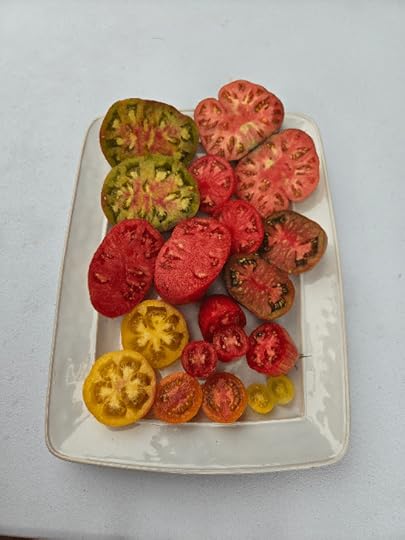 Saving Seeds becomes addicting- so many possibilities open up!Save only the Very Best Seeds
Saving Seeds becomes addicting- so many possibilities open up!Save only the Very Best SeedsSave seeds from the best plants in your garden- selecting these ‘top performing’ plants will build seed and plants for next year.
This is how us humans domesticated and increased our harvests from wild seeds over the centuries- but it is still worth doing over a few years. After over a decade of saving pole beans mine produce better than the original packet I bought.
Do not save seeds from diseased plants or plants that didn’t thrive in your garden.
Patience with NatureOne thing to keep in mind when starting to save seeds is that we’re really just helping nature along. Waiting long enough for Mother Nature to do her work is a big part of the initial learning curve.
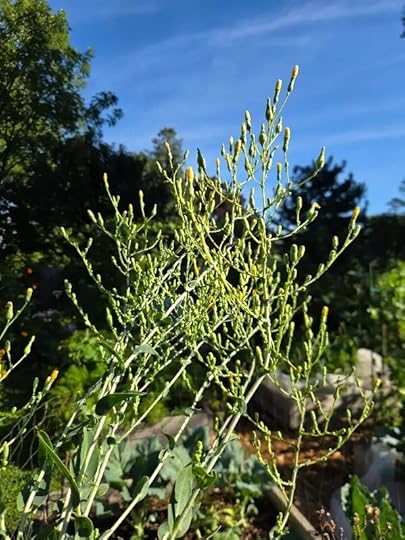 Lettuce take a VERY long time to fully mature, this is flower stage.
Lettuce take a VERY long time to fully mature, this is flower stage.Both waiting for the seed to be ripe enough on the plant and waiting long enough for the seed to be fully dry enough to put into storage!
Plants will tell you when their seeds are ready. They give you signs, like color changes or simply starting to fall off the plant. Lettuces for example are like dandelions with their seeds; it becomes obvious.
Not all seeds are as showy with their seed ripeness, which brings me to Heritage Farm Field crew Leader, Rochelle’s advice, “spend a little time learning about the plant you are saving seeds from. Each crop has some specific information on how to work with it- but don’t be afraid to mess up. There are so many easy plants to start with.”
EASY TO SAVE SEEDS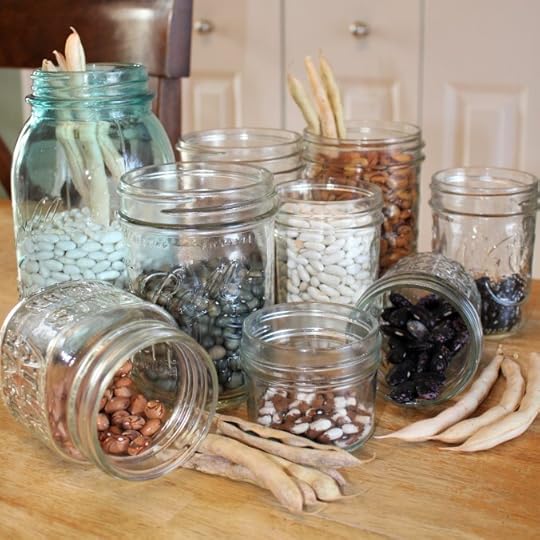 Saving Pea + Bean Seeds
Saving Pea + Bean SeedsThese two have such similar saving techniques we can talk about them together. Save bean and pea seeds on the plant and let them mature rather than eat them.
Peas and Beans are self-pollinating plants. You don’t have to worry about them cross-pollinating and mixing the strains. To save your seed, wait until the peas/beans are brown and dried on the vine. The pods will become papery, turning a yellow to brown color. Ideally, you should be able to hear the dry seeds rattling inside the pods. This is usually about 4 weeks after the peas and beans are ready for eating.
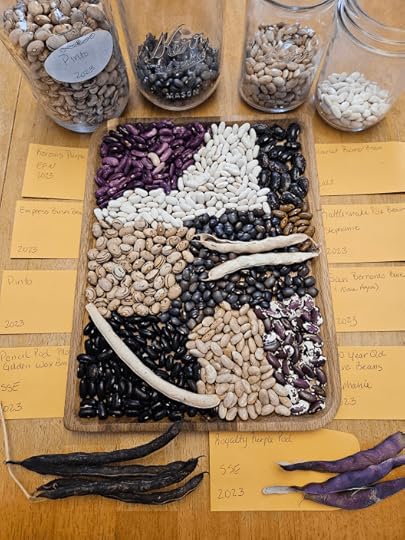
After harvesting these seeds I usually leave them in their pods in a paper bag to dry further in a dry closet until I happen on them in winter and then shell them out, keeping them in paper envelopes or bags. I always say I’m going to be more intentional this season- but if that’s all I’ve done, and it has worked in the past you know you can handle this, too.
At the end of the season, watch for bean rust while waiting for beans to dry on the vine.
Over winter watch for little black bugs (bean weevils) emerging from the bean pods.
Saving Tomato Seeds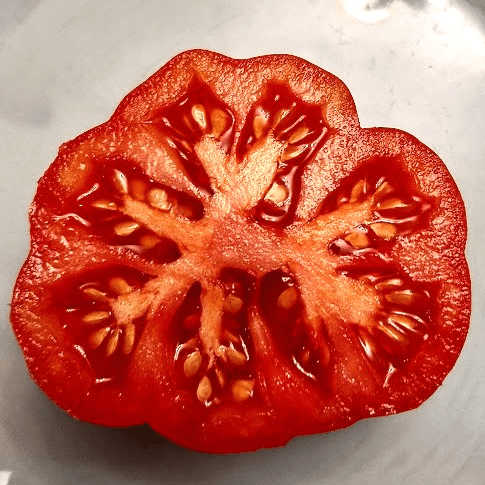
The good news on saving tomato seeds is that you get to save your seeds and eat your tomatoes too! Tomato seeds are ripe the same time as their fruits– Yay!!
To harvest seeds just squish out the juice and seeds into a jar.
There are two main schools of thought on how to best save tomato seeds.
Fermenting then drying -or- just drying.
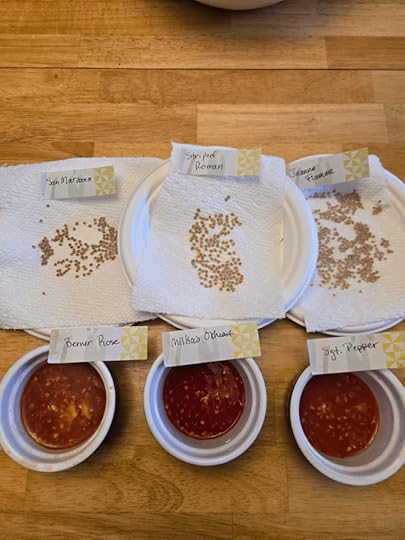 Tomato seeds being fermented, then dried
Tomato seeds being fermented, then driedAnyone who’s eaten a tomato probably knows about the little gelatin glob that encapsulates each seed. This gelatin helps the tomato seed to hold off on germinating by keeping it protected. This layer of protection keeps seed from germinating to quickly.
I like to get rid of the gel by fermenting it away before drying, but some think that drying alone breaks it down enough. To ferment tomato seeds, simply squeeze the tomato seeds + juice into a jar and let sit on a counter for 2-3 days. Rinse and strain off juice until just seeds are left, then transfer to paper towels/paper plates.
I use both methods as the season allows, but do think I get better germination with fermented seeds.
Tomatoes may cross-pollinate with each other, so if you are serious about saving these- plan on growing different varieties on opposite ends of your garden.
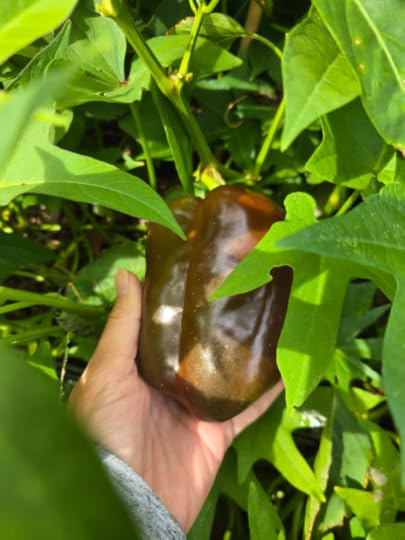 Saving Bell Pepper Seeds
Saving Bell Pepper SeedsSweet peppers are one of the simplest seeds to save. The hardest part for northern gardeners like myself, is getting the peppers to full maturity in our growing season. But luckily you just harvest the fruits when fully ripe, you don’t have to wait until they are over-ripe to collect viable seeds.
Simply separate seeds from the ribs, careful not to break the seed coating. Dry on a paper towel for a week or so, then store in a paper envelope.
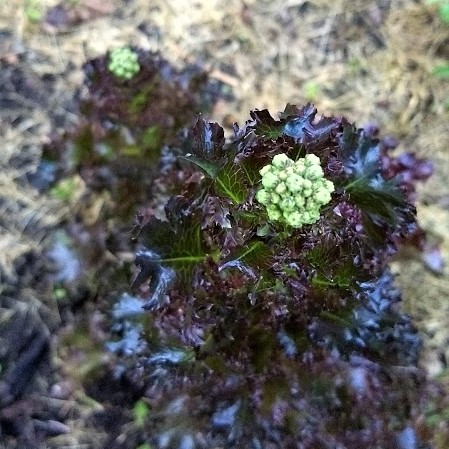 Saving Lettuce Seeds
Saving Lettuce SeedsPatience is key when saving lettuce seeds. You’ll need to get your plants started early and let them bolt. Bolting is when the plant sends up flower stalk that blooms and eventually sets seeds.
Then your job is to wait as the tight flowers SLOWLY turn to white fluff – and dry on the plant before harvesting the seeds. The final seed heads remind me of showy little seed poofs just like dandelions.
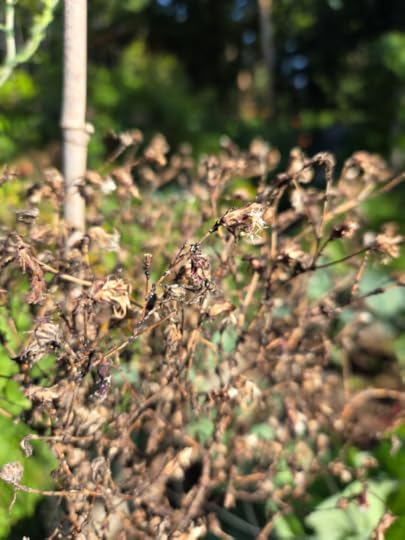
The trick is to catch these seeds at full maturity but before they drop to the soil. If I can remember in time, I try to wrap my seed lettuces in a mesh bag so they can continue to ripen on the plant. Then I chop the plant stalk late into the fall after the plant has died back. That way I can harvest as much seed as possible without it falling to the ground. Lettuce will self seed this way as well.
These are also seeds that you need to wait for dry weather to harvest. You can shake into a bowl or bucket- then blow away the fluff and chaff (extra plant material). One plant will give you enough seeds to share with your entire neighborhood, or a local seed library!
Seed StorageClick HERE for how to save these annual flower seeds.
It is recommended to store them in a glass jar or plastic bag. Air tight containers will hold seeds viable for longer, you just need to make sure they are fully dried out before sealing it to avoid growing mold instead of more food.
I mostly keep them in paper bags or paper envelopes, (or glass jars) but always in a cool dark area.
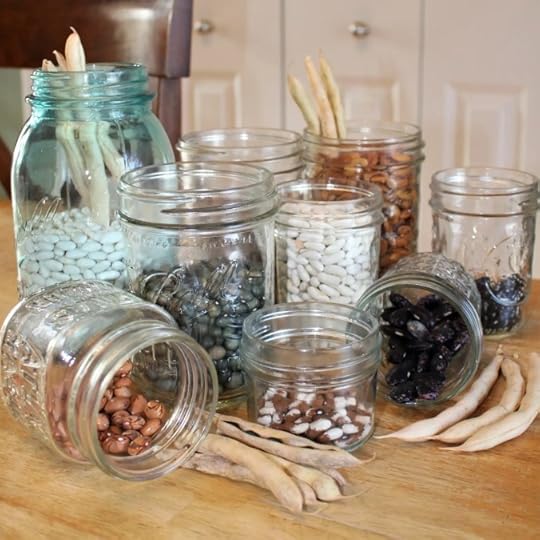
This SEED VIABILITY CHART from High Mowing Organic Seed Co. shows the typical time that different seeds stay viable for best germination rates.
Seed Savers Exchange is a great place to start if you want to buy savable seeds.
I hope this quick overview inspires you to try and save some seeds- for the first time, or save some new seeds…
What questions do you have? What seeds are you most likely to start saving?
Dig In,
Michelle
The post Seed Saving: Vegetables appeared first on Forks in the Dirt.
Forks in the Dirt
- Michelle Bruhn's profile
- 4 followers



